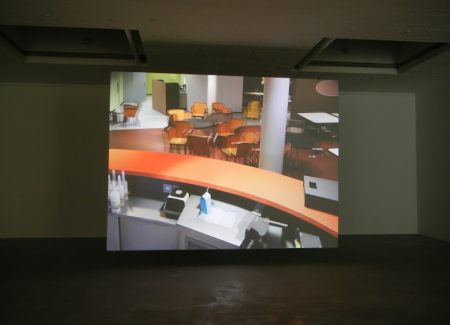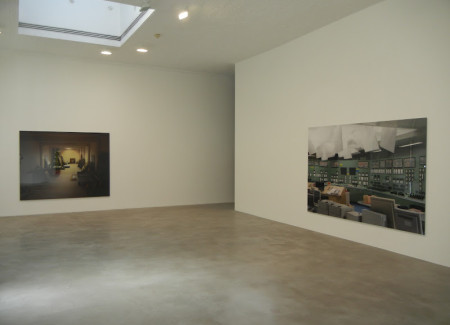JTF (just the facts): A total of 3 large scale color photographs hung unframed against white walls in the front gallery space, with 1 video projection shown in an adjacent darkened viewing room. The photographs are c-prints mounted on plexiglas, ranging in size from 55×45 to 79×118. The film and sound installation has a projected size of 148×197. No edition information was provided on the checklist. All of the works were made in 2011 or 2012. (Installation shots at right.)
Comments/Context: Thomas Demand is one of the reigning kings of the contemporary photographic installation. Starting with a source photograph, the artist creates an elaborate cut paper construction, reproducing the scene in exacting detail, but paring it down to a composition of geometric solids and shapes. He then photographs the resulting installation, making an image that is a recognizable representative of the original, but abstracted from its truth and reality. This generalization process drains away context and specificity, creating a simplified visual language that is both intellectual and reductivist. Demand is a kind of meta-matician, his works occupying an analytical space above the place where photographs normally operate.
His newest photographs continue his use of this meticulous methodology, documenting Whitney Houston’s last meal at the Beverly Hilton, the shadowy vault at the Wildenstein Institute where dozens of long missing paintings were recently found, and the control room of the Fukushima Daichi nuclear power plant after the evacuation. When seen via Demand’s cardboard short hand, the settings are neutered, our reactions and emotions muted by the subtle rigidity of the abstractions. There is still something sadly poignant about the disarray of sugar packets and leftover salad dressing on the room service cart and the jumbled white ceiling tiles which float like elegant weightless origami above the knobs, switches and computer readouts, but the feelings are detached and aloof rather than hot and immediate. His translation has sucked the juice out of these moments, leaving them dry and academic, like empty ghosts of themselves.
The short film on view amplifies the focus on Demand’s astounding craftsmanship. Beginning with YouTube video taken by a security camera on a cruise ship during a heavy storm, Demand painstakingly recreated the ship’s cafe, with its seating arrangements of chairs and tables and its bright orange counter with a cash register and bar supplies. Over the course of 2400 individual frames, the objects were then moved inch by inch (with apparent understanding of the laws of physics), the resulting full speed film depicting the crashing back and forth of the entire scene as the ship rocked and tumbled. There is something impressively precise and scientific about this work, where the furniture rumbles across the frame like a herd of buffaloes, the wind blows, the pendant lights sway, and the bucket of lemon slices topples over, all with increasing violence until the chaos subsides, straws, napkins and a lone pink shoe left strewn amidst the destruction. It’s hard not to enjoy the whole raging spectacle, but there isn’t much emotional payoff; I found myself feeling respect for Demand’s prowess as a set builder (and wondering about how the sound was synched to the imagery), rather than paying much attention to the fate of the ship and its passengers.
Curators have long had a love affair with Demand, as his work is both conceptually rigorous and wholly original, and I do think there is something very intriguing about using increasing abstraction to push a photograph to the edge of its ability to communicate meaning. But there is a cerebral quality to this construction exercise that often times leaves me cold; my brain engages with systematic nature of his recreation process, but the pictures ultimately fail to grab me. Finding this tipping point of engagement and leaving the abstract physical objects to imply narrative is part of the interest of course, and I actually found these newest works by Demand more engaging than some of his prior efforts. His work seems to me more about questions than answers, the resulting images almost always unresolved.
Collector’s POV: Unfortunately, even after two visits to the gallery and repeated emails to the directors and staff, I was unable to get anyone to respond to my simple questions about the prices and the edition sizes for the photographs on view. There was no printed checklist with prices on it, and the usual pass off to the sales director was never followed up, which is puzzling, since I would assume collector inquiries would merit at least cursory attention. I’m not sure if this was just inadvertent incompetence or deliberate indifference, since I have had nothing but perfectly friendly and cooperative encounters with the gallery in the past.
In any case, if I subsequently find out the price information, I will post it in the comments; other collectors who have had more success than I are encouraged to do so as well. On the auction front, Demand’s work is becoming more routinely available in the secondary markets, with at least a handful of works up for sale every year. Recent prices have ranged between $15000 and $260000 for the works in small editions (3, 5, or 6), while works from larger editions (100) have typically found buyers between $1000 and $5000.







